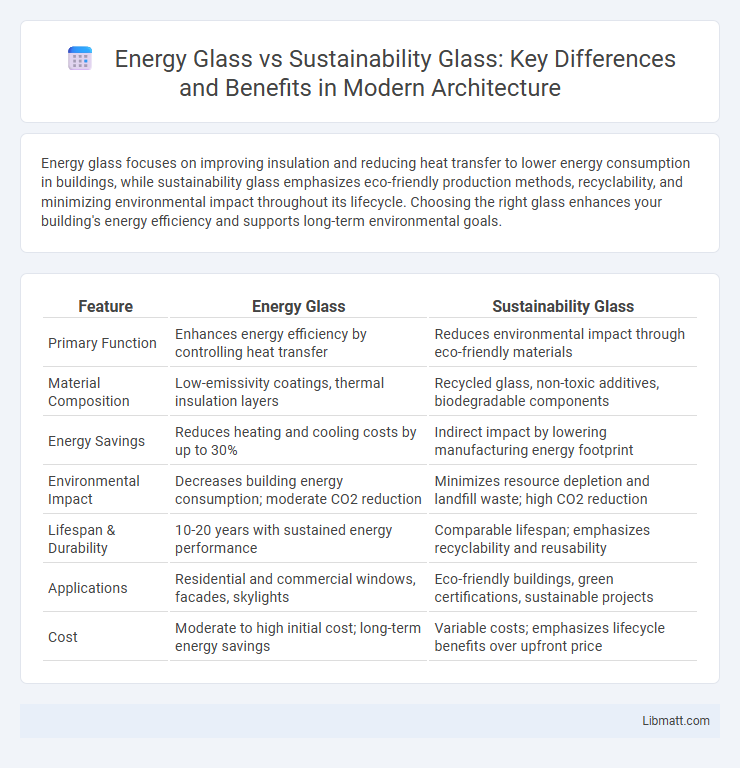Energy glass focuses on improving insulation and reducing heat transfer to lower energy consumption in buildings, while sustainability glass emphasizes eco-friendly production methods, recyclability, and minimizing environmental impact throughout its lifecycle. Choosing the right glass enhances your building's energy efficiency and supports long-term environmental goals.
Table of Comparison
| Feature | Energy Glass | Sustainability Glass |
|---|---|---|
| Primary Function | Enhances energy efficiency by controlling heat transfer | Reduces environmental impact through eco-friendly materials |
| Material Composition | Low-emissivity coatings, thermal insulation layers | Recycled glass, non-toxic additives, biodegradable components |
| Energy Savings | Reduces heating and cooling costs by up to 30% | Indirect impact by lowering manufacturing energy footprint |
| Environmental Impact | Decreases building energy consumption; moderate CO2 reduction | Minimizes resource depletion and landfill waste; high CO2 reduction |
| Lifespan & Durability | 10-20 years with sustained energy performance | Comparable lifespan; emphasizes recyclability and reusability |
| Applications | Residential and commercial windows, facades, skylights | Eco-friendly buildings, green certifications, sustainable projects |
| Cost | Moderate to high initial cost; long-term energy savings | Variable costs; emphasizes lifecycle benefits over upfront price |
Introduction to Energy Glass and Sustainability Glass
Energy glass enhances building efficiency by incorporating low-emissivity coatings and insulating properties that reduce heat transfer and lower energy consumption. Sustainability glass prioritizes eco-friendly materials and manufacturing processes, emphasizing recyclability and reduced carbon footprint throughout its lifecycle. Your choice between energy glass and sustainability glass impacts both operational energy savings and environmental responsibility.
Defining Energy Glass: Technology and Benefits
Energy glass utilizes advanced coatings and insulation technology to enhance thermal performance by reducing heat transfer and maximizing natural light. This innovation improves energy efficiency in buildings, lowering heating and cooling costs while minimizing carbon footprints. Your choice of energy glass supports sustainable construction by combining functionality with eco-friendly benefits.
What is Sustainability Glass? Key Features and Advantages
Sustainability glass is an eco-friendly glazing solution designed to reduce environmental impact through enhanced energy efficiency and the use of recyclable or low-impact materials. Key features include high thermal insulation, reduced greenhouse gas emissions, and the ability to maximize natural light while minimizing heat loss or gain. Your choice of sustainability glass contributes to lowering carbon footprints and can improve building performance in compliance with green building standards.
Energy Efficiency: Comparing Energy Glass vs Sustainability Glass
Energy glass maximizes energy efficiency by incorporating low-emissivity coatings that reduce heat transfer, minimizing heating and cooling costs. Sustainability glass prioritizes eco-friendly materials and manufacturing processes while also enhancing insulation to reduce environmental impact. Your choice between energy glass and sustainability glass can significantly influence both building performance and long-term energy savings.
Environmental Impact: Analysis of Both Glass Types
Energy glass reduces environmental impact by enhancing insulation, which cuts heating and cooling energy consumption in buildings, leading to lower greenhouse gas emissions. Sustainability glass emphasizes eco-friendly materials and manufacturing processes, aiming to minimize resource extraction and waste. Your choice between energy glass and sustainability glass should consider both operational energy savings and the overall lifecycle environmental footprint.
Performance in Green Building Certifications
Energy glass enhances building energy efficiency by reducing heat transfer and lowering HVAC loads, contributing significantly to LEED and BREEAM certifications. Sustainability glass incorporates recycled materials and eco-friendly manufacturing processes, earning points for material reuse and reducing embodied carbon in green building assessments. Your choice between these glasses impacts both operational energy savings and sustainability credits, optimizing performance in various green building certification frameworks.
Cost Effectiveness and Lifecycle Considerations
Energy glass offers cost-effective benefits through enhanced insulation, reducing heating and cooling expenses over time. Sustainability glass emphasizes eco-friendly materials and recyclability, often leading to higher upfront costs but lower environmental impact throughout its lifecycle. Your choice should balance immediate savings with long-term ecological benefits for optimal lifecycle performance.
Applications in Modern Architecture
Energy glass enhances building energy efficiency by reducing heat loss and gain, making it ideal for commercial skyscrapers and residential green buildings. Sustainability glass incorporates recycled materials and improves natural light utilization, supporting eco-friendly designs in office complexes and educational facilities. Both types contribute to LEED certification goals by maximizing insulation performance and minimizing environmental impacts.
Challenges and Limitations of Each Glass Type
Energy glass often faces challenges related to higher initial costs and reduced natural light transmission, which can affect indoor lighting quality and heating needs. Sustainability glass may encounter limitations in scalability and performance consistency due to reliance on recycled or alternative materials that vary in availability and quality. Both types require careful balance between energy efficiency, environmental impact, and long-term durability to optimize their contribution to green building practices.
Future Trends: Energy Glass and Sustainability in Construction
Energy glass technology is evolving to enhance thermal insulation and solar control, significantly reducing building energy consumption and carbon footprints. Sustainability glass integrates recycled materials and innovative coatings to improve durability and environmental impact, aligning with green building certifications such as LEED and BREEAM. Future trends emphasize smart glass with adaptive transparency and energy-harvesting capabilities, driving the next generation of eco-efficient construction.
energy glass vs sustainability glass Infographic

 libmatt.com
libmatt.com